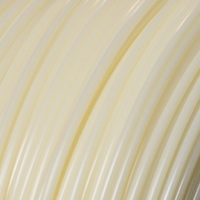 An increasing number of personal 3D printer manufacturers are switching their products from using standard 3mm plastic filament (either ABS or PLA plastic) to a smaller size: 1.75mm. One of the early converts was PP3DP’s Up! 3D printer, which came with a 1.75mm extruder and smaller nozzle to match. In those early days 1.75mm filament was hard to find and Up! owners typically purchased their material directly from PP3DP. Since then we’ve seen MakerBot, RepRap and just recently BotMill have converted to this format.
An increasing number of personal 3D printer manufacturers are switching their products from using standard 3mm plastic filament (either ABS or PLA plastic) to a smaller size: 1.75mm. One of the early converts was PP3DP’s Up! 3D printer, which came with a 1.75mm extruder and smaller nozzle to match. In those early days 1.75mm filament was hard to find and Up! owners typically purchased their material directly from PP3DP. Since then we’ve seen MakerBot, RepRap and just recently BotMill have converted to this format. Why has this change occurred? What’s the big deal with 1.75mm and correspondingly smaller extrusion nozzles? Here’s some things to consider:
- Thinner filament can be heated faster because it takes less time for heat to penetrate to the centre of the filament, implying faster printing and less hefty heating elements
- 1.75mm filament weighs less per unit length and thus the extruder mechanism has less mass to worry about when shifting to and fro
- Thinner filament can be bent more easily, implying smaller tighter and smaller coils and possibly smaller storage mechanisms
- Smaller nozzles are more capable of avoiding ooze when the flow can be slightly reversed by the extruder’s stepper motors
No doubt this is a good move for the manufacturers and 3D printer owners. But can you buy 1.75mm filament? Yes! There seems to be plenty of choices now from shops such as MakerBot, MakerGear, 3D Ink, Ultimachine and many others, who currently offer spools in varying sizes ranging from US$15-22 per pound (US$33-48 per kg).
Now then, what are we going to do with that seventeen pounds of green 3mm filament?


How could we forget Faberdashery? Doh! *slaps head* Thanks!
How could we forget Faberdashery? Doh! *slaps head* Thanks!
Don't forget Faberdashery in the UK.
Don't forget Faberdashery in the UK.
I'm glad you named shops where we can buy 1.75mm filament.
I'm glad you named shops where we can buy 1.75mm filament.
No surprise here! Stratasys uses 1.75mm filament.
No surprise here! Stratasys uses 1.75mm filament.